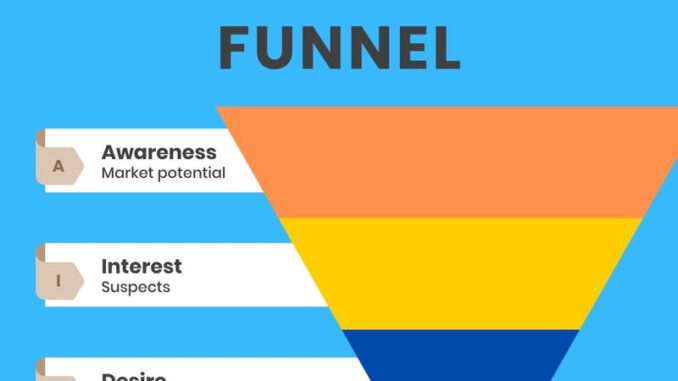
The AIDA framework is a popular model in marketing that outlines the steps necessary to take a customer from initial Awareness of a product or service all the way through to making a purchase, which is known as Action.
This framework is often represented as a funnel, with a wide opening at the top for Awareness and a narrow opening at the bottom for Action.
The steps in between are Interest and Desire, which represent the customer’s level of engagement with the product or service.
In this article, we’ll take a closer look at each step in the AIDA framework and how you can use it to grow your business.
What is the digital marketing funnel?
A funnel is a tool that businesses can use to map out the customer journey from initial awareness of a product or service all the way through to purchase. This funnel is often represented as a series of steps, starting with broad awareness at the top and narrowing down to more specific interests and desires before finally arriving at action, or purchase. Each step in the funnel corresponds to a different stage in the customer journey, and understanding these stages can help you better map out your marketing campaigns and objectives.
How can the digital marketing funnel help your business grow?
The digital marketing funnel can help your business grow by providing a framework for you to map out your marketing campaigns and objectives. In addition, understanding the stages of the customer journey can help you better tailor your marketing messages to the needs and wants of your target audience. By following the steps of the digital marketing funnel, you can ensure that your campaigns are focused on the right things at the right time and that your business is primed for growth.
Key steps to using the digital marketing funnel
There are four key steps to using the digital marketing funnel:
Awareness: The first step is to generate awareness of your product or service among your . This can be done through a variety of marketing channels, such as paid advertising, social media, PR, and content marketing.
Interest: Once you have generated awareness, you need to pique the interest of your target audience and get them to start engaging with your brand. This can be done through targeted content that speaks to their needs and wants, as well as through offering incentives such as free trials or discounts.
Desire: Now that you have their attention, it’s time to build up the desire for your product or service. This can be done through continued content marketing, as well as through social proof such as customer testimonials and case studies.
Action: The final step is to get the target audience to take action, or make a purchase. This can be done through a variety of means, such as providing a strong call to action, a sense of urgency, or a special offer.
Using the digital marketing funnel to drive growth
By following the steps of the funnel, businesses can ensure that their marketing campaigns are focused on the right things at the right time and that they are primed for growth.
1. Define your audience
The first step of the digital marketing funnel is to define your target audience. This step is important because it will determine the rest of your funnel strategy. Without a clear understanding of who your target customer is, it will be difficult to create content or campaigns that resonate with them.
To define your target audience, consider things like their demographics, interests, and pain points. Once you have a good understanding of who your target customer is, you can move on to the next step.
2. Create compelling content
The next step in the digital marketing funnel is to create that will capture the attention of your target audience. This step is important because it is the foundation of your entire funnel strategy. If your content is not compelling, your audience will not be engaged, and you will not be able to drive them further down the funnel.
To create compelling content, start by thinking about what your target customer wants to see. What information are they looking for? What are their pain points? What would be helpful for them to know? Once you have a good understanding of what your target customer is looking for, you can start creating content that resonates with them.
3. Drive traffic to your content
Now that you have created compelling content, it’s time to start driving traffic to it. This step is important because it will determine how many people see your content and how engaged they are with it. There are a variety of ways to drive traffic to your content, but some of the most effective include SEO, social media marketing, and .
4. Convert your traffic into leads
The next step in the digital marketing funnel is to convert your traffic into leads. This step is important because it is what will ultimately generate revenue for your business. There are a variety of ways to convert traffic into leads, but some of the most effective include using landing pages and lead forms.
5. Nurture your leads
The final step in the digital marketing funnel is to nurture your leads. This step is important because it will determine whether or not your leads convert into customers. Nurturing your leads involves providing them with valuable information and resources that will help them make a purchase decision.
We can help you in business growth with Digital Marketing. Contact us today at

Leave a Reply